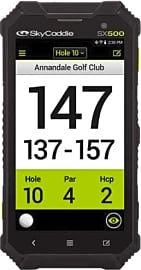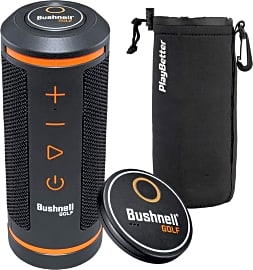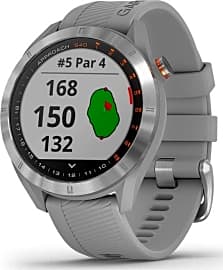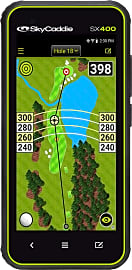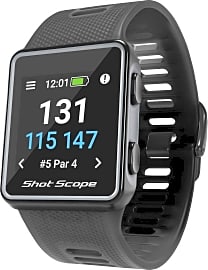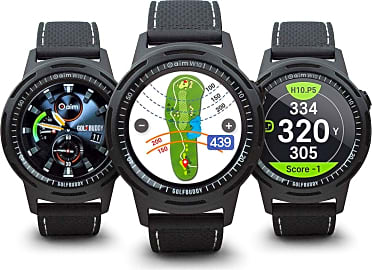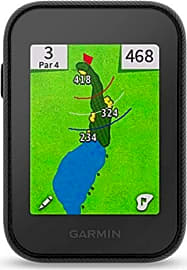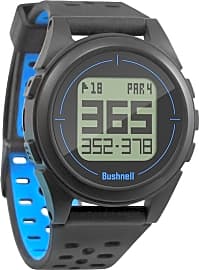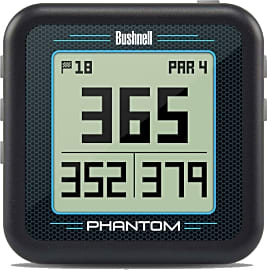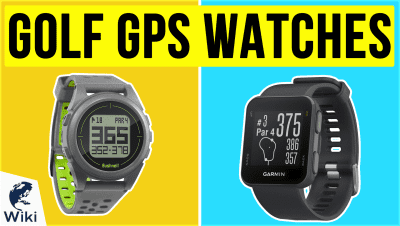The 10 Best Golf GPS Units

This wiki has been updated 42 times since it was first published in June of 2015. Whether you're a scratch player or spend most of your time in the rough, one of these golf GPS units will help you accurately measure how far away the hole is and select the right club for any situation on tens of thousands of courses worldwide. They come in wearable and handheld options, and many also highlight hazards, so, hopefully, you can avoid those nasty ponds and sand traps. When users buy our independently chosen editorial picks, we may earn commissions to help fund the Wiki.
Editor's Notes
April 06, 2021:
It ended up being a very busy round of updates, as widespread availability issues decimated much of our list. In the end, the only models that we wound up retaining were the Bushnell Phantom, Bushnell Neo Ion 2, Golf Buddy Aim W10 and Garmin Approach S40. This left our rankings with quite a lot of room to spare, and we chose to focus are new additions on handheld models, since we also maintain a separate list for golf GPS watches.
We added the SkyCaddie SX400 and SkyCaddie SX500 Power Bundle, as well the Garmin Approach G30 and Garmin Approach G80 Birdie Bundle, believing that our list could stand to benefit from a mid-range and high-end option from both companies. You could argue that these units have more in common than they do separating them, but there are some key differences between them, and the most obvious one might be screen size. When it comes to this, SkyCaddie comes out ahead of Garmin, with the SX400 featuring a four-inch screen, while the SX500 boasts a five-inch display. By contrast, the G30 and G80 have 2.3- and 3.5-inch screens, respectively.
We also chose to list bundle deals for the SX500 and G80, as both were available for nearly the same price as the bare device, and came with some interesting bonuses. While the SX500’s kit comes with a zippered storage case and a small portable power bank, the G80 includes a set of club covers and a seven-implement multitool. The G80 also doubles as a launch monitor, and is able to offer loads of useful information that enthusiasts are likely to appreciate.
The Shot Scope V3 was the only watch we introduced this time around. We liked that it gathered a lot of data – it tracks more than 100 statistics – and didn’t require a subscription service, and we also liked that it featured replaceable wristbands, in case you like to switch your style up from time to time.
The Bushnell Wingman Speaker sports a design that definitely stands out in the category, presenting as an unassuming Bluetooth speaker, to the untrained eye. However, in addition to providing you with up to 10 hours of music, you can use its detachable remote to let you know every time you want it to issue an audible alert notifying you how far you’ve got to the next hole. It looks like a cool little unit, and it’s priced competitively, but its lack of a screen can be limiting. However, if you don’t mind carrying your smartphone on the fareway, you can pair it with the company’s golf app, which lets you get some of that utility back.
For other game-improving solutions, check out our lists of golf simulators, swing analyzers and impact bags.
December 27, 2019:
During this update, we replaced the Bushnell Neo Ghost with the Bushnell Phantom, a newer and more affordable device that boasts the addition of Bluetooth and an integrated magnet for connecting it to your cart or bag. We also completely eliminated the Izzo Swami 5000 due to reported charger issues and the fact that any settings a user input are deleted when the device is shut down, which can get very annoying. Additionally, the TomTom Golfer 2 was removed due to user reviews of it displaying inaccurate yardage.
While determining which models we should add to our recommendations, we looked at things like ease of use, cost, accuracy, and additional functionality. We were also aware of the different preferences players have for their GPS, which is why you'll find a combination of handheld devices, watches, and other wearables recommended here.
When it comes to functionality, few can match the Arccos 360 Shot Tracker, which is a full performance tracking system. This means that, in addition to GPS data, it will record and analyze various shot metrics, and then provide useful feedback that can help players improve their game. It is worth noting though, that a system like this is not tournament legal and is designed solely for training purposes and casual play.
If you want a color touchscreen model that is tournament legal, we recommend the Garmin Approach G6, Garmin Approach G8, and Golf Buddy GB3 VTX if you want a handheld device, or the Golf Buddy Aim W10 and Garmin Approach S40 if you prefer a watch. Just note that you may have to turn off some of these devices advanced functionality, such as slope compensation on the G8 or club averages on the G6.
While the majority of the devices on our list features a screen that displays relevant information, the Voice Caddie VC300SE takes a different approach. As implied by the name, it provides you with course data audibly. It is worth pointing out the Golf Buddy GB3 VTX is also capable of doing this, but with the added functionality a screen offers.
Special Honors
Garmin MARQ Collection If you're the kind of golfer who doesn't mind spending a little more in the name of style, then this line of watches is for you. There's a dozen colorful looks to choose from, and if you can't make your mind up, a five-piece signature set is also available — but brace yourself for its five-figure price tag. garmin.com
Choosing The Right Golf GPS Unit
There are plenty of affordable options that give you information about distance to the green and that will help you select the right club based on your location.
All decent golf GPS units can help a golfer by supplying two critical pieces of information. These are the layout of the course on which he or she is playing, and the golfer's specific position on said course. When you know where you stand, you can make informed decisions that will help you play your best possible game of golf.
Any good golf GPS unit will come pre-loaded with information about thousands of courses. You should have instant access to images and info about the topography of courses spread all around the globe and for most of the 15,300 or so golf courses in America. This makes a golf GPS unit a handy tool whether or not you are actually there on the links. When you can study a course remotely from the comfort of the clubhouse, not to mention from your own armchair at home, you can plan your game at your leisure.
If you think you will enjoy or benefit from careful study of a course before you set foot on the links, then a golf GPS unit with a larger screen, a full color display, and plenty of details is the right choice for you. These tools can help you feel like you know a course before you ever even see it, and can give amateur and professional golfers alike a competitive edge.
If you prefer a compact unit you can comfortably slip into a pocket and periodically refer to while you walk the course itself, then a smaller, simpler golf GPS unit might be the right choice. There are plenty of affordable options that give you information about distance to the green and that will help you select the right club based on your location. These units aren't ideal for armchair "research" but are great for planning which club will get you from fairway to green.
If you're willing to spend a larger chunk of change on your golf GPS unit, you can rather have it both ways, though. Certain wristwatch style options display course details in full color and with plenty of helpful information, and also are small enough to be comfortably worn during the hours you spend playing a full 18 holes.
Other Smart Steps In The History Of Golf
There have been many advances in the sport of golf over the past several hundred years. The first 18 hole course was established at St. Andrews in Scotland in the year 1764, for example (though golf had in fact been played there since the 1550s). Early golf balls were made of wood or of leather pouches stuffed with dozens of boiled and softened feathers. These "featherie" golf balls could get very expensive — but then again, so are premium modern models.
In fact, some of the first widely produced electric golf carts used a battery design to control flight surfaces on the iconic B-17 Flying Fortress heavy bomber.
Balls were made from various natural materials well into the 20th Century, including tree sap used both as filler and for shells. The addition of dimpling allowed a player to put greater spin on the ball, improving control and aerodynamics. Liquid core balls and synthetic shells took over in the mid 20th Century, with materials such as urethane replacing resins sourced from sap.
Golf carts first saw prominent use in the 1950s. Motorized carts had been used on golf courses decades earlier, they were often gasoline powered and limited to the ferrying of disabled or elderly players. Electric carts saw widespread use for players of all physical abilities beginning in the mid 20th Century thanks largely to advancements made in electrical propulsion achieved during the World War II era. In fact, some of the first widely produced electric golf carts used a battery design to control flight surfaces on the iconic B-17 Flying Fortress heavy bomber.
In the past few decades, golf clubs have gone through myriad improvements in relatively little time when compared to the centuries long arc of development. Newly repurposed materials such as graphite and carbon fiber are used to create lightweight, strong clubs that are highly "reactive," meaning they deliver superlative kinetic energy to a struck golf ball.
And of course the golf GPS unit makes use of one of the most remarkable technologies developed in recent years, putting the power of the space age into the hands of dedicated golfers worldwide.
A Few Words On GPS Technology
Most people in America today know what GPS is, in that they know it can help one find a location and/or can provide them with directions to that place if needed. Fewer people know what the acronym GPS actually stands for, though. The letters are sourced from the words Global Positioning System, and that's just what the technology does: it uses satellites up in orbit to help determine a precise position down here on the surface of the earth.
Fewer people know what the acronym GPS actually stands for, though.
First conceived of in theory in the 1950s, GPS became a viable technology in 1960 when the United States Navy, working in tandem with several other government agencies, launched the first satellite navigation system, which was called TRANSIT.
Modern GPS systems can function anywhere on the globe, provided the receiver (be it in your car's dashboard or in your pocket on the golf course) has a line of sight connection to at least four satellites. These multiple points of contact can be used to accurately establish a location by measuring relative distance between each satellite and the unit seeking the information. The technology has been widely available to the public since the mid 1990s, and is now an indispensable part of many aspects of our lives, from transportation to weather prediction to getting directions to a friend's house.


